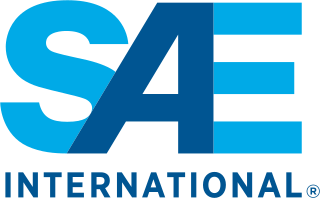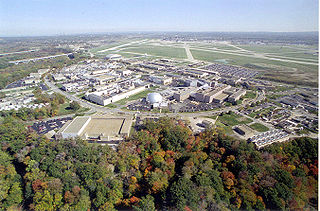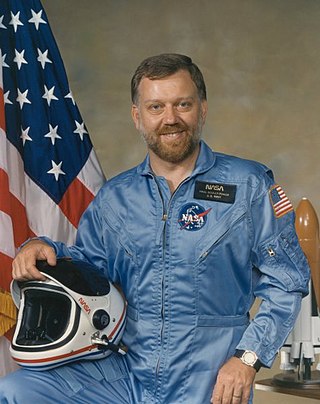This timeline of artificial satellites and space probes includes uncrewed spacecraft including technology demonstrators, observatories, lunar probes, and interplanetary probes. First satellites from each country are included. Not included are most Earth science satellites, commercial satellites or crewed missions.
The Lockheed Martin Corporation is an American aerospace, arms, defense, information security, and technology corporation with worldwide interests. It was formed by the merger of Lockheed Corporation with Martin Marietta in March 1995. It is headquartered in North Bethesda, Maryland, in the Washington, D.C. area. As of January 2022, Lockheed Martin employs approximately 115,000 employees worldwide, including about 60,000 engineers and scientists.

SAE International is a global professional association and standards organization based in Warrendale, Pennsylvania, United States. Formerly the Society of Automotive Engineers, the organization adopted its current name in 2006 to reflect both its international membership and the increased scope of its activities beyond automotive engineering and the automotive industry to include aerospace and other transport industries, as well as commercial vehicles including autonomous vehicles such as self-driving cars, trucks, surface vessels, drones, and related technologies.

NASA John H. Glenn Research Center at Lewis Field is a NASA center within the cities of Brook Park and Cleveland between Cleveland Hopkins International Airport and the Rocky River Reservation of Cleveland Metroparks, with a subsidiary facility in Sandusky, Ohio. Its director is James A. Kenyon. Glenn Research Center is one of ten major NASA facilities, whose primary mission is to develop science and technology for use in aeronautics and space. As of May 2012, it employed about 1,650 civil servants and 1,850 support contractors on or near its site.

Paul Desmond Scully-Power, AM GOSE FRAeS is an Australian-American oceanographer, technology expert and business executive. In 1984, while a civilian employee of the United States Naval Undersea Warfare Center, he flew aboard NASA Space Shuttle mission STS-41-G as a Payload Specialist. He was the first Australian-born person to journey into space, and the first astronaut with a beard.

The Vision for Space Exploration (VSE) was a plan for space exploration announced on January 14, 2004 by President George W. Bush. It was conceived as a response to the Space Shuttle Columbia disaster, the state of human spaceflight at NASA, and as a way to regain public enthusiasm for space exploration.
As a federal agency, the National Aeronautics and Space Administration (NASA) receives its funding from the annual federal budget passed by the United States Congress. The following charts detail the amount of federal funding allotted to NASA each year over its history to pursue programs in aeronautics research, robotic spaceflight, technology development, and human space exploration programs.
The NASA Space Science Data Coordinated Archive (NSSDCA) serves as the permanent archive for NASA space science mission data. "Space science" includes astronomy and astrophysics, solar and space plasma physics, and planetary and lunar science. As the permanent archive, NSSDCA teams with NASA's discipline-specific space science "active archives" which provide access to data to researchers and, in some cases, to the general public. NSSDCA also serves as NASA's permanent archive for space physics mission data. It provides access to several geophysical models and to data from some non-NASA mission data. NSSDCA was called the National Space Science Data Center (NSSDC) prior to March 2015.

The Environmental Research Aircraft and Sensor Technology, or ERAST program was a NASA program to develop cost-effective, slow-flying unmanned aerial vehicles (UAVs) that can perform long-duration science missions at altitudes above 60,000 ft (18,000 m). The project included a number of technology development programs conducted by the joint NASA-industry ERAST Alliance. The project was formally terminated in 2003.
Cambridge Scientific Abstracts was a division of Cambridge Information Group and provider of online databases, based in Bethesda, Maryland, before merging with ProQuest of Ann Arbor, Michigan, in 2007. CSA hosted databases of abstracts and developed taxonomic indexing of scholarly articles. These databases were hosted on the CSA Illumina platform and were available alongside add-on products like CSA Illustrata. The company produced numerous bibliographic databases in different fields of the arts and humanities, natural and social sciences, and technology. Thus, coverage included materials science, environmental sciences and pollution management, biological sciences, aquatic sciences and fisheries, biotechnology, engineering, computer science, sociology, linguistics, and other areas.
NASA spin-off technologies are commercial products and services which have been developed with the help of NASA, through research and development contracts, such as Small Business Innovation Research (SBIR) or STTR awards, licensing of NASA patents, use of NASA facilities, technical assistance from NASA personnel, or data from NASA research. Information on new NASA technology that may be useful to industry is available in periodical and website form in "NASA Tech Briefs", while successful examples of commercialization are reported annually in the NASA publication Spinoffs. The publication has documented more than 2,000 technologies over time.

NASA Research Park, situated near San Jose, California, operates as a research facility under the auspices of NASA. It is focused on fostering collaboration among government entities, academic institutions, industries, and nonprofit organizations. It was established in the fall of 2002.
The National Institute of Aerospace (NIA) is a non-profit research and graduate education institute headquartered in Hampton, Virginia, near NASA's Langley Research Center.

The NASA Authorization Act of 2014 is a bill that would authorize the appropriation of $17.6 billion in fiscal year 2014 to the National Aeronautics and Space Administration (NASA). NASA would use the funding for human exploration of space, the Space Launch System, the Orion spacecraft, the Commercial Crew Program, the International Space Station (ISS), and various technological and educational projects.

Since its establishment in 1958, NASA has conducted research on a range of topics. Because of its unique structure, work happens at various field centers and different research areas are concentrated in those centers. Depending on the technology, hardware and expertise needed, research may be conducted across a range of centers.
ANSI/EIA-649, "National Consensus Standard for Configuration Management", is an industry standard for configuration management.

TechPort is a Technology Portfolio System for the National Aeronautics and Space Administration (NASA). The TechPort system was created in response to a request by the Office of Management and Budget (OMB), resulting in the NASA Performance Goal 3.4.1.5 and APG 3.4.1.5: ST-12-17.
Document, coordinate, and prioritize Agency-level technology strategic investments to ensure NASA has a balanced portfolio of both near-term NASA mission (pull) technologies and longer-term transformational (push) technologies that benefit both Agency programs and national needs.
Ensure that 75 percent of all NASA technology projects are recorded in the portfolio database and are analyzed against the prioritizations in the space technology roadmaps.
Radha Krishnaiah Chetty Pandipati is an Electronics and Communications Engineer and author.

Commercial Lunar Payload Services (CLPS) is a NASA program to hire companies to send small robotic landers and rovers to the Moon. Most landing sites are near the lunar south pole where they will scout for lunar resources, test in situ resource utilization (ISRU) concepts, and perform lunar science to support the Artemis lunar program. CLPS is intended to buy end-to-end payload services between Earth and the lunar surface using fixed-price contracts. The program was extended to add support for large payloads starting after 2025.

Petroleum Remediation Product (PRP) is a registered trade name of United Remediation Technology for a line of biodegradable wax-based hydrocarbon adsorbents and bioremediation agents. PRP was created in the 1990s by NASA’s Jet Propulsion Laboratory and has been used to assist in remediating oil spills such as the 2010 Deepwater Horizon oil spill. PRP is a powder composed of microscopic hollow spheres of wax up to 150 microns in size.











